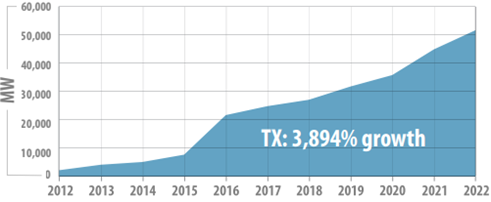Blog | Federal Investment
March 6, 2025
By Chaney Keck, Communications Assistant, BCSE
Cross-posted from Business Council for Sustainable Energy
Clean energy industries have been growing over the past decade, providing good-paying jobs while supporting a cleaner, healthier future for communities across the nation. This growth can clearly be seen at the state level, where there’s been great strides in renewable energy generation, energy efficiency improvements, and grid electrification, to name a few.
In the 2023 State of Clean Energy report, the Clean Energy Business Network breaks down the progress of the clean energy transition at the state and local level, looking at data from 2022. Through individual state infographics and top 10 state lists that consider key clean energy growth categories, the analysis tracks clean energy deployment, jobs, CO2 emissions, energy efficiency, federal grants for energy R&D, and private sector investment across all 50 states and the District of Columbia. Here’s a look at 10 states that stood out as clean energy leaders.
California employed a total of 623,972 clean energy workers in 2022, more than any other state. It also earned the best energy efficiency score of 47/50 on the American Council for an Energy-Efficient Economy (ACEEE) State Energy Efficiency Scorecard, excelling in policy areas like transportation and appliance standards. Approximately $45 billion in private capital was invested in clean energy projects across California in the year following the passage of the federal Inflation Reduction Act, partly thanks to the legislation’s broad tax credits and local-level grants designed to stimulate clean energy deployment.

In 2019, Washington passed the Clean Energy Transformation Act (CETA), setting in motion the state’s plan to transition to a carbon-free economy by 2045. Three years later, in 2022, Washington’s power sector emissions were the lowest in the country at a rate of 0.09 tCO2/MWh. Driving this number is the in-state electricity generation mix, which consists of 76% renewable energy, 12% natural gas, and 8% nuclear.

Washington’s neighbor Idaho has also made its name in renewable electricity generation. Thanks to its wealth of hydroelectric and wind resources, Idaho generates 75% of in-state electricity from renewable energy, the fourth largest percentage of any state. At a rate of 0.12 tCO2/MWh, the state also has the second lowest emitting power sector in the country.

Texas manages and operates the largest renewable energy industry of any state, largely composed of wind and solar – employing 396,071 workers in 2022. To support the state’s largely independent grid and vast population, Texas has built up a diverse energy mix, seeing approximately $35 billion in private clean energy investment between 2021 and 2023 alone. The state ranked highest in newly built renewable energy capacity at 6,552 MW in 2022.

New York
With the help of $1.7 billion in funding from the Department of Energy (DOE) in fiscal year 2022, New York is making strides toward modernizing its grid and designing innovative approaches to decarbonization. The state scores 39/50 on the ACEEE State Energy Efficiency Scorecard, with high marks on efficient transportation and its energy waste reduction policy. As for jobs, New York has the third largest clean energy workforce in the country with 230,119 employees as of 2022.

In 2022, Vermont was the only state to generate nearly 100% renewable energy, with an abundance of hydroelectric power in and around the state and a diligent energy policy track record. The state also has an impressive energy efficiency score of 35.5/50, powered by state-led initiatives in water-saving, lighting, and weatherization standards.

South Dakota has crept up the state clean energy ranks over the past decade, becoming a major renewable energy exporter and tripling its wind generation capacity since 2012. With 84% of in-state electricity generation coming from renewables, South Dakota’s power sector emissions are the fourth lowest in the country at 0.13 tCO2/MWh.

Thanks to major private and public investment over the past decade, including $2.5 billion in federal funding received from the 2021 Infrastructure Investment and Jobs Act (IIJA), the clean energy transition is well underway in Iowa. In 2022, the state ranked 5th in the nation for newly built renewable energy capacity at 779 MW. Sixty-five percent of Iowa’s in-state electricity generation comes from renewables, with wind energy representing the main renewable generation source.

Since 2013, Minnesota has seen a 31% increase in energy productivity, earning it an energy efficiency score of 32/50 in 2022. Additionally, in the months after the IRA passed, the state invested over $1.6 billion in clean energy technologies and development. The 2023 Minnesota Energy Factsheet, produced by Clean Energy Economy Minnesota and BCSE, provides further highlights of the state’s progress on the energy transition.

Maine is making strides in its clean energy transition, with renewable sources contributing 63% of in-state electricity generation in 2022. The same year, natural gas represented 31% of the state’s generation mix. Maine has also made progress in state energy efficiency policy, advancing energy-saving incentives, equity-based programs, and educational mechanisms. The state scored 35.5/50 on the ACEEE State Energy Efficiency Scorecard and was named most improved in 2022.

In addition to state leadership, private sector investment is driving the clean energy transition across the United States. Check out BCSE’s Clean Energy Coast to Coast Map to see where BCSE member companies are powering energy efficiency and clean energy deployment at the state level.
Visit the Clean Energy Business Network’s 2023 State of Clean Energy report to find more state-by-state comparisons and individual state clean energy factsheets.
